If you're looking for gluten-free dinner rolls that are fluffy, delicious, and actually remind you of the rolls you used to love, look no further! These pull-apart yeast rolls are light, soft, and airy thanks to Caputo Fioreglut, a special gluten-free flour.
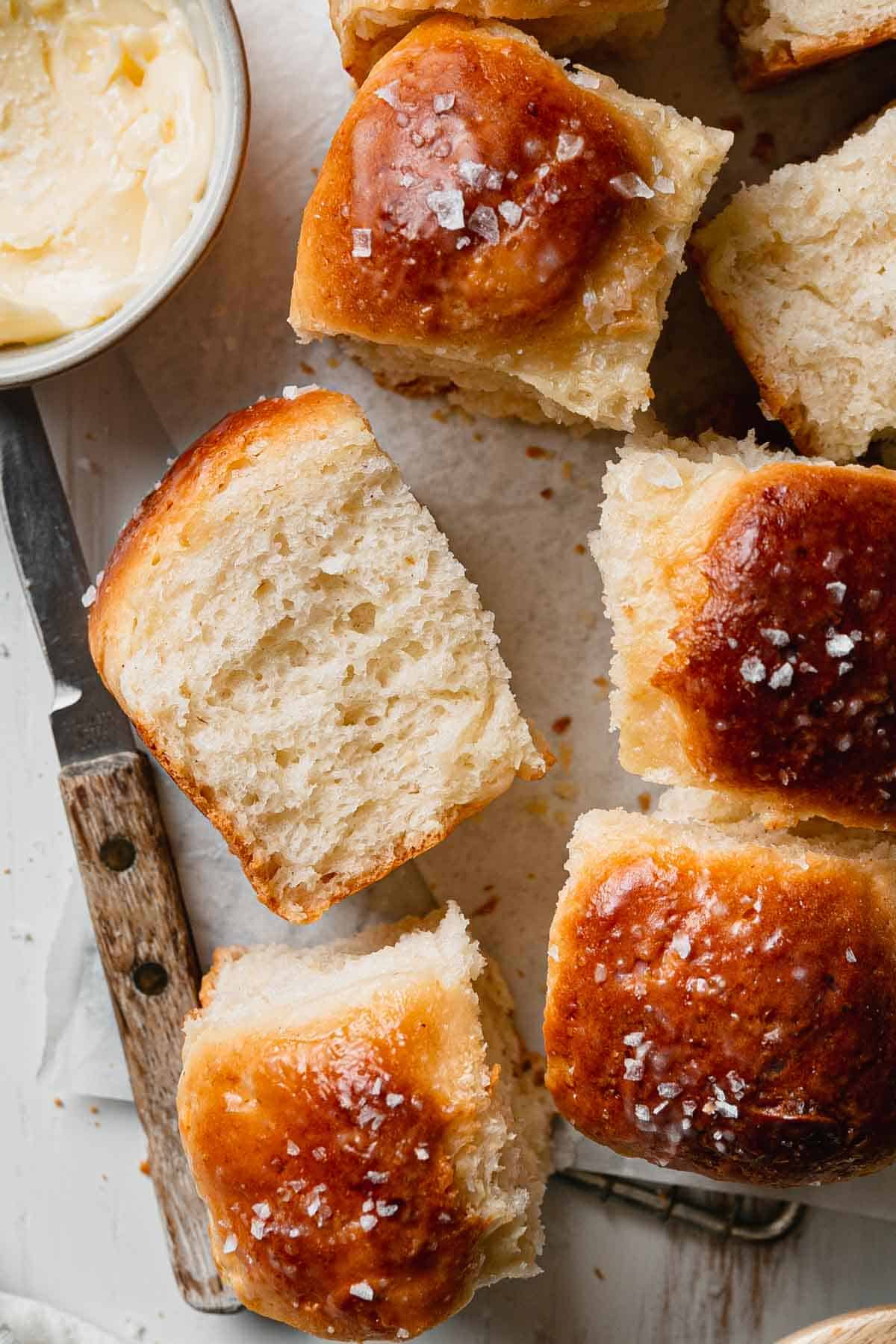
Why You Need This Recipe
A soft and fluffy dinner roll is the perfect accompaniment to a special meal, like Easter, Thanksgiving dinner. Or those slow-cooked Sunday suppers, like gluten-free Italian beef or a simple gluten-free spaghetti sauce.
There's just something magical about spreading softened butter on a warm, pillowy roll! It's the ultimate comfort food and brings back fond memories!
Unfortunately, being gluten-free makes it very difficult to recreate that magic at times. I've made several gluten-free yeast dinner rolls over the years and none of them were even comparable to a regular roll.
That was until I discovered the secret ingredient that changed everything when it comes to gluten-free yeast breads. We'll get to that in just a minute, but first here's a few more reasons you'll love this recipe:
- Easier to make than even a regular roll!
- You only need a few simple ingredients and they're easy to find!
- You can make these rolls start to finish in about 2 hours, which for a yeast bread is pretty quick!
- Make them ahead if you need to! Perfect for Thanksgiving prep!
- Dairy-Free option provided!
- The best part? They taste like a regular dinner roll! Now that's magical!
Secret Ingredient - Caputo Fioreglut Gluten-free Flour
If you are familiar with my amazing gluten-free pizza dough, gluten-free cinnamon rolls, gluten-free Hawaiian rolls, or gluten-free burger buns recipes, you may already be aware of this secret. To make gluten-free rolls, that actually resemble the 'regular' version, it's all in the flour you choose.
Not all gluten-free flours are created equal, especially when it comes to yeast breads. The flour used in these rolls is Caputo Fioreglut. It really does make a huge difference in the outcome of the recipe. This flour comes from Italy (or Amazon, haha, wink, wink) and it is the secret to success.
I have even created a gluten-free sourdough bread recipe with Caputo Fioreglut! The recipe uses gluten-free sourdough starter, instead of commercial yeast.
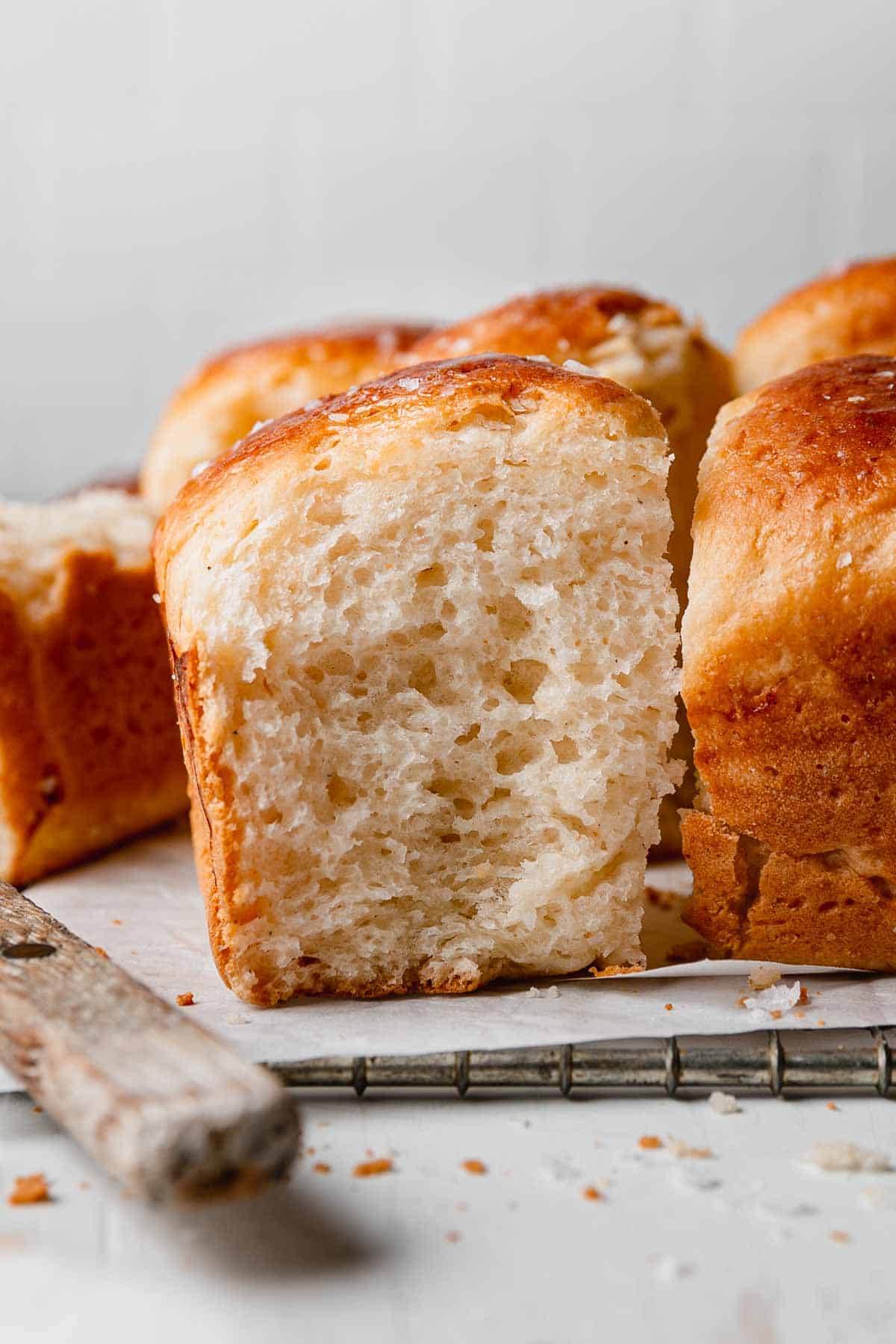
Gluten-Free Wheat Starch
I do want to mention that this flour is not suitable for someone with a wheat allergy since it contains gluten-free wheat starch. I went in-depth about this flour in the best gluten-free pizza recipe post and I also covered gluten-free wheat starch in this article, so I won't go into all the details again, but if you want to know more, be sure to check those articles out!
In a nutshell, what makes this flour unique to other gluten-free flours is that it contains gluten-free wheat starch. Gluten-free wheat starch is used in some gluten-free baked goods to enhance their texture and structure.
It also has that reminiscent wheat-like taste and smell that is missing from other gluten-free flours.
If you're unfamiliar with gluten-free wheat starch, rest assured the flour is certified gluten-free in Italy, tests well below the 20ppm requirement, and is deemed safe for those with Celiac disease or gluten-intolerance, but since it does contain wheat starch, it should be avoided for someone with an allergy or intolerance to wheat itself.
Can You Use Other Gluten-free Flours?
I'll be honest, yes and no. Does the recipe work? Yes. Is it as good? No.
In the image below you can see a side by side comparison of this roll made with Fioreglut on the left and Namaste perfect flour blend on the right. I also tested this recipe with Cup4Cup and Bob's Red Mill 1:1 baking flour. All had similar results to the Namaste roll.
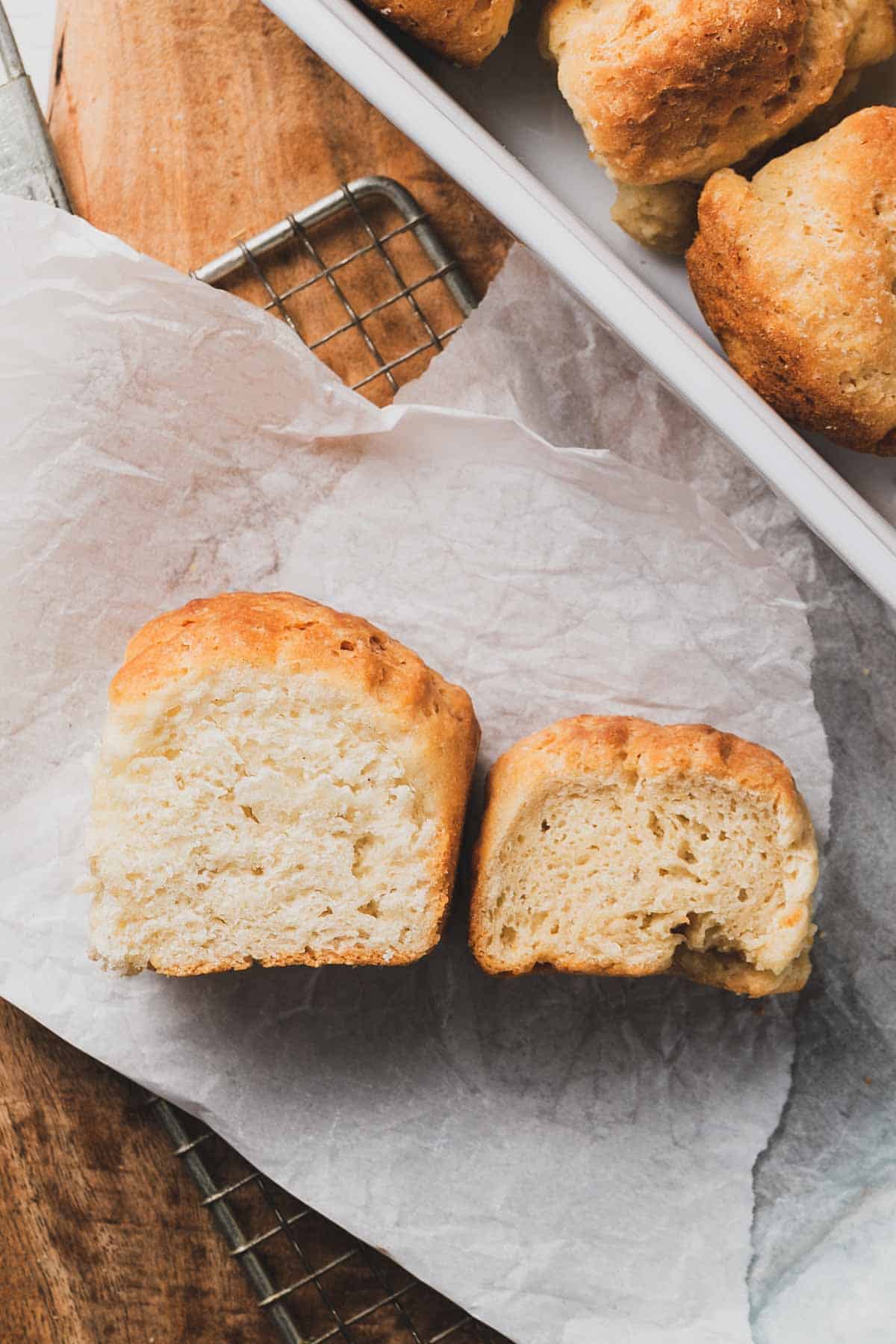
The roll made with Caputo Fioreglut is about twice the size of the rolls made with other flours, which also translated to twice the airiness and twice the tenderness. The other rolls were unfortunately dense and just not as great.
Suffice it to say, proceed at your own risk but I do not recommend other flours for this particular recipe. If you really want a good roll that is as close to "normal" bread as possible, Caputo Fioreglut is the flour to use.
Ingredients Needed
Aside from Caputo Fioreglut and possible psyllium husks, these rolls don't require any special ingredients and you may already have most of it on hand.
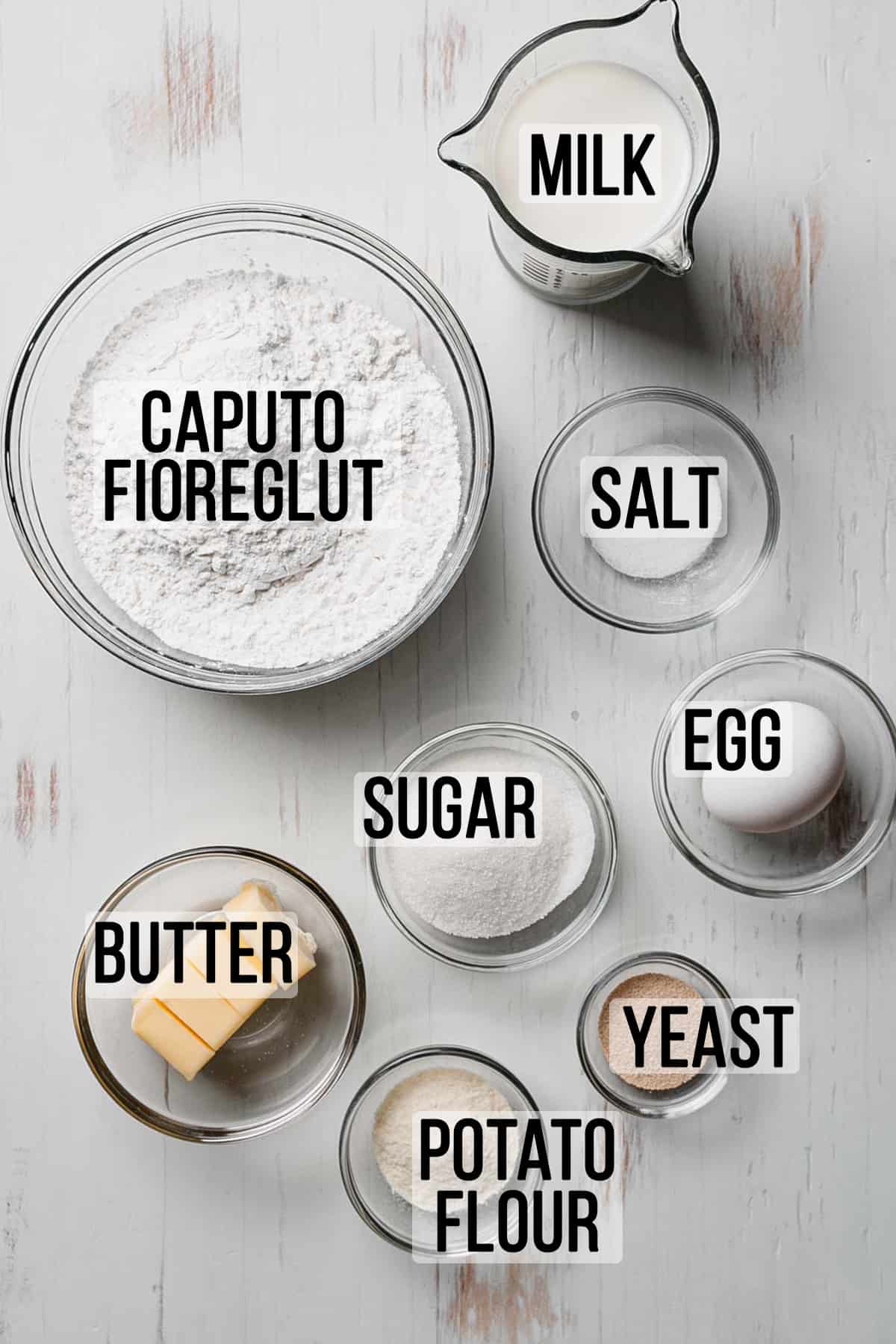
- Caputo Fioreglut flour: You can find this gluten-free flour most easily on Amazon.
- Instant Yeast: This is important! Use RapidRise, Bread Machine, or Instant Rise yeast. These types of yeast can all be mixed directly into the flour and do not need to be dissolved first.
- Potato Flour: Plain mashed potato flakes can be used as a substitute. You can also omit this ingredient and use an equal amount of Caputo Fioreglut flour.
- Psyllium Husk: This helps make the dough less sticky and difficult to work with while adding structure. Use whole husks if possible.
- Milk: I used 2% milk. Whole milk would also be fine here.
- Butter: I used salted butter, either salted or unsalted butter is fine.
- Large Egg adds structure. I haven't tested without the egg but since there is only one egg needed, a flax egg might work if you need an egg-free option.
- Salt and Sugar: Both are needed for flavor and for yeast activation, please do not omit.
Notes about yeast:
- Remember the recipe calls for instant yeast. If you only have active dry yeast, be sure to dissolve it first in the warm milk for 5 minutes before mixing with the rest of the ingredients.
- Make sure your yeast is fresh! Check the expiration date. If your yeast is expired or older than 4-6 months, get fresh yeast.
Gluten Free and Dairy Free Dinner Rolls
To make gluten-free and dairy-free dinner rolls, simply substitute the butter with vegan butter, such as Earth Balance Vegan Buttery Sticks, and the milk for your favorite non-dairy alternative, such as almond or soy milk.
Equipment Needed
- Stand Mixer: A stand mixer really makes it simple to mix this recipe. Unfortunately, I would not recommend a hand mixer for this recipe because the dough is just too thick. If you don't have a stand mixer, it can be done by hand but it will be a bit of a work out.
- Kitchen Scale: It's important to accurately measure the ingredients for this recipe so a digital scale is highly recommended! They are inexpensive and can come in handy for all baking, not just making yeast breads.
- Loaf Pan: A standard size loaf pan (8.5 x 4.5 inches) is the perfect pan to help these rolls get a nice rise. You can also use an 8-inch square baking pan. The rolls will be a little more squatty, still delicious though!
- Digital Thermometer: A digital instant read thermometer is so helpful here! You want to make sure your milk is the proper temperature for yeast activation. I use and love the Thermapen, it's a great thermometer!
- Cookie Scoop: A cookie scoop can be used for more than cookies! It will help you get uniformly sized portions of dough.
- Parchment Paper: You can line the pan with parchment paper for easy removal from the pan.
How to Make Gluten-free Dinner Rolls
The best part about gluten-free breads is that it they can actually be quite easy to make, easier than regular dough! It's basically just dump, mix, scoop, rise, and bake!

- Step 1: Whisk the dry ingredients together in the bowl of a stand mixer. Fit the stand mixer with the paddle attachment.
- Step 2: Warm the milk and butter to between 120-130°F. Then blend these wet ingredients into dry ingredients slowly on low speed. Then blend in the room temperature egg.
- Step 3: Mix the dough on medium speed for 2 minutes. If you don't have a stand mixer, you could do this by hand, just bear in mind the dough is thick and sticky and your arm will get a good workout!
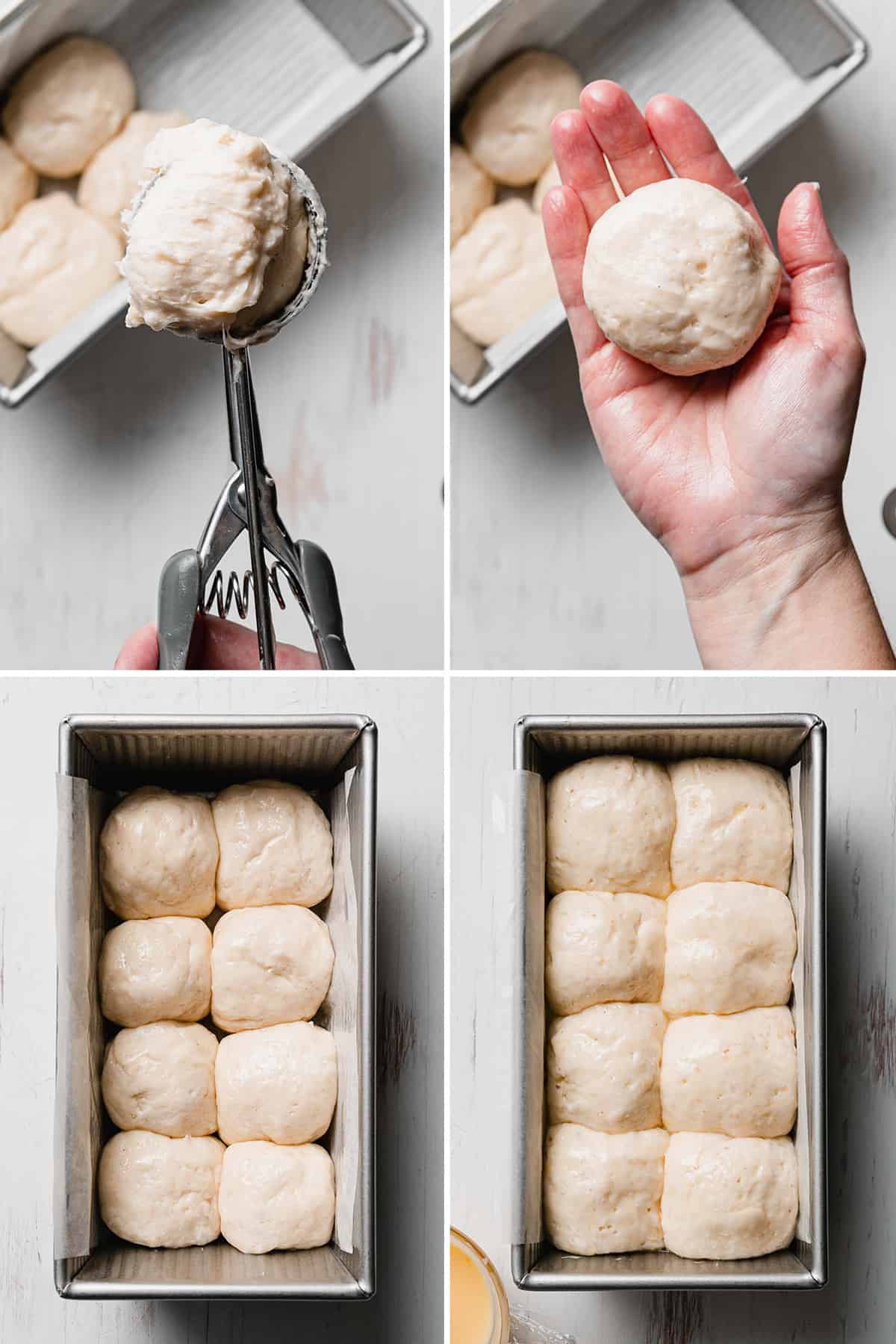
- Step 4: After the dough is mixed, use a large cookie scoop to scoop eight heaping ¼ cup portions.
- Step 5: With a greased hand, roll the dough into a smooth ball.
- Step 6: Place the balls of dough into a greased standard-sized loaf pan.
- Step 7: Let the dough rise in a warm place for 1 hour.
Pan Tip: You can see the rolls are quite tight in the pan, even before they rise. You want to use a baking pan that doesn't have too much spare room around the rolls before they rise so that the rolls rise upwards instead of outwards. This makes for a taller, nicer looking roll.
Proofing Tip: If your kitchen is cold, it will be harder to proof your rolls and get the proper rise. In this case, use your microwave as a warm spot to proof your bread dough. To do this:
- Boil about 1 cup of water in the microwave.
- Open the microwave and place your rolls inside.
- Close the door.
- Let the rolls rise until doubled in size!
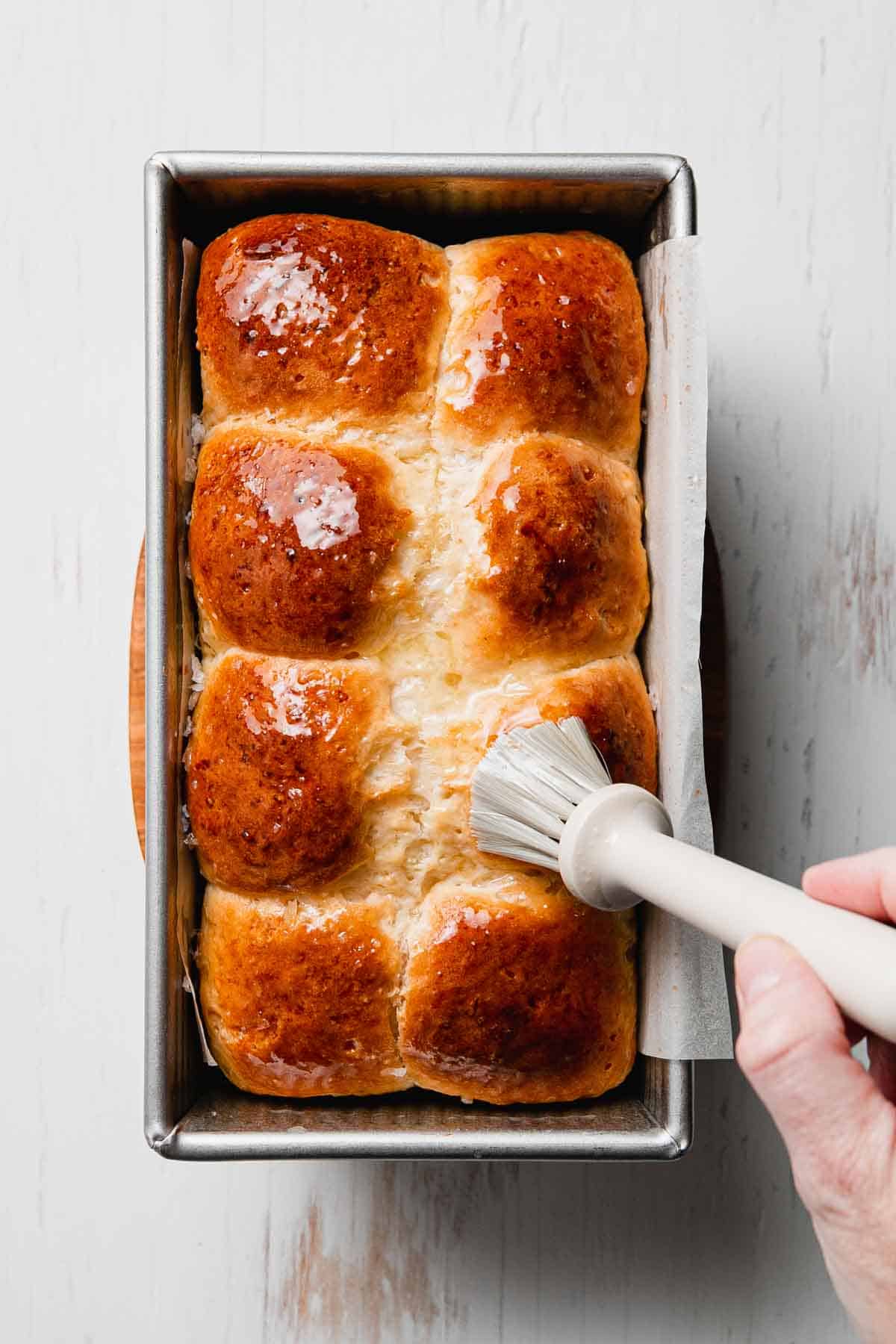
- Step 8: Once the dough has risen, brush with an egg wash and bake until golden brown and at least 190°F in the center.
- Step 9: After the rolls have baked, brush them with melted butter and sprinkle with sea salt if desired. Serve warm.
These rolls are definitely best when enjoyed fresh, so my recommendation is to bake the rolls just ahead of dinner but there are some make-ahead options.
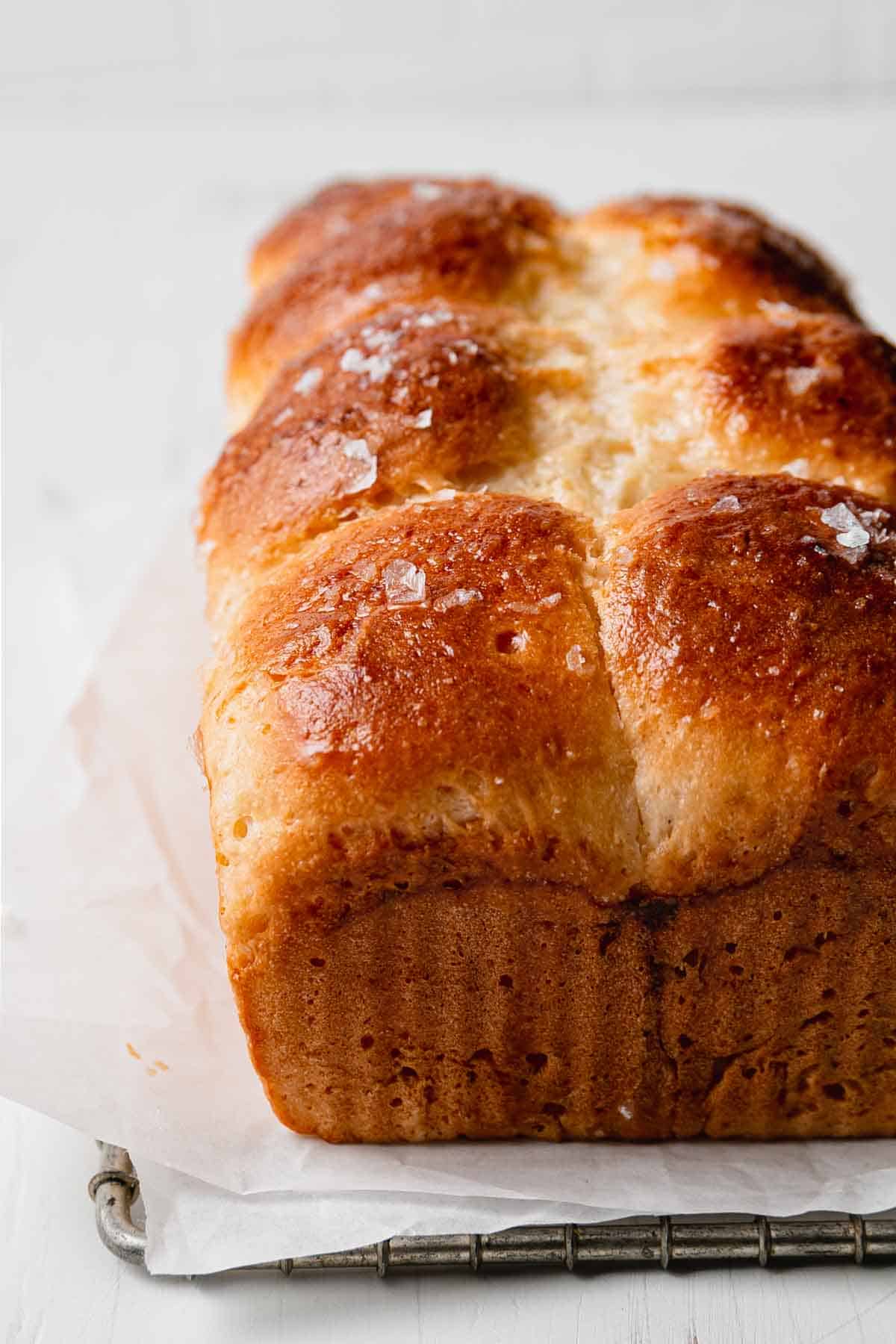
How to Make Ahead
If you're making these rolls as part of your Thanksgiving, Easter, or some other big dinner, you may be wondering how to make them ahead to save some time and prep work on the day of the meal. The good news is there are some great options which means you can have a freshly baked roll virtually anytime you want!
Bake Ahead
You can bake the rolls about one day in advance. Allow the rolls to cool completely and store at room temperature, wrapped tightly with plastic wrap.
Remove the plastic wrap and rewarm the rolls in a 350°F oven for 15-30 minutes, just until warmed through. Brush with butter and serve.
Refrigerate Unbaked Rolls
Make the rolls as above and allow them to rise until doubled in size. Keep them tightly wrapped and then store them in the refrigerator for up to one day. Allow the rolls an hour or two to come to room temperature before baking. Then, bake according to instructions.
Freeze Unbaked Rolls
Make the rolls and allow them to rise. Freeze the whole pan, tightly wrapped in plastic wrap.
Remove frozen rolls from the freezer. Allow them to thaw and come to room temperature for at least 4 hours. You can also thaw overnight in the refrigerator. Then bake according to instructions.
How to Store
Store leftover rolls in an airtight container for up to three days. You'll need to rewarm them in the oven or microwave to soften them.
Top Recipe Tips
- Dough Tips:
- Use the right flour! The only recommended flour for this recipe is Caputo Fioreglut.
- The batter will be thick, sticky, and batter-like. This is normal. Do not add extra flour.
- Make sure your ingredients are the proper temperature. The milk/butter needs to be between 120-130°F. The egg needs to be at room temperature. This is important for yeast activation.
- Use Instant or Rapid Rise yeast. This type of yeast does not need to be dissolved first in warm water or milk.
- Use yeast that is fresh! If your yeast is older than 4-6 months or past the expiration date, you need to buy new yeast.
- Weigh your ingredients if possible. This will give the most accurate measurements. Click the metric button on the recipe card.
- Use the proper sized pan as noted in the recipe. This will aid in getting the proper rise out of the rolls.
- Shaping Tips: (***Please Read***)
- Let the batter rest for 5-10 minutes before shaping the rolls. This gives the psyllium a chance to absorb some of the moisture and makes them easier to shape.
- Grease your hands with nonstick cooking spray or olive oil when rolling the dough into balls. This will prevent the dough from sticking to your hands!
- Be sure to use a "gentle" hand when shaping the rolls. The dough is not like traditional yeasted doughs and is more batter-like. Some readers have complained about this, saying the rolls are hard to shape. I do acknowledge this but the extra moisture in the recipe is needed in order for them to get a good rise and be light and fluffy. With greased hands, you should be able to gently roll each mound of dough into a ball. I've done this quite a few times now and am able to form the rolls!
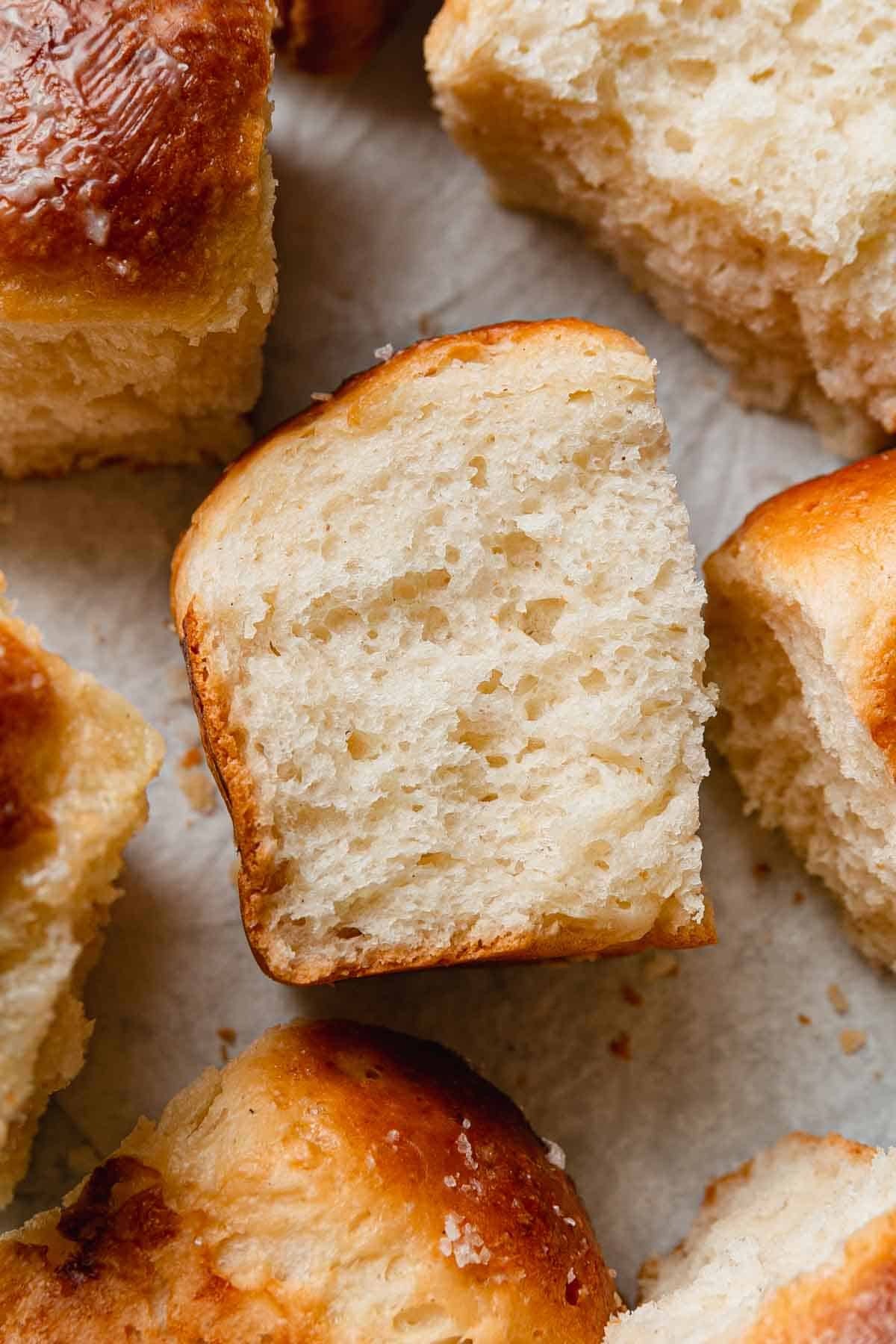
I hope you enjoy this gluten-free yeast roll recipe! They will be the perfect addition to your next holiday meal! These tasty bread rolls are just one of the many great gluten-free Thanksgiving recipes I have for you, so be sure to check out more those recipes before you go!
Gain access to our FREE exclusive mini-series:
Gluten-Free Baking and Lessons Learned!
Plus, be the first to know about new recipes and exciting announcements!
📩 Sign up for the Mini-Series Here! 📩
More Gluten-Free Yeast Breads
Recipe
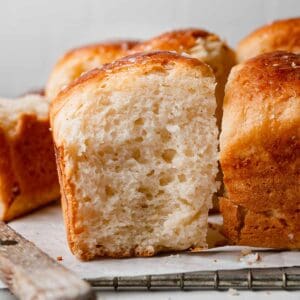
Gluten-free Yeast Dinner Rolls
Ingredients
- 2 cups Caputo Fioreglut gluten-free flour blend, other flours not recommended
- ¼ cup granulated sugar
- 1 Tablespoon potato flour, or 2 Tablespoons plain mashed potato flakes, or equal amount Caputo Fioreglut
- 1 Tablespoon Whole Psyllium Husks
- 1 ¼ teaspoons Instant or Rapid Rise Yeast
- ¾ teaspoon kosher salt
- 1 cup milk, warmed to 120-130°F. (Plus 1 tablespoon for egg wash.)
- 4 Tablespoons butter, melted (Plus extra for brushing on top.)
- 1 large egg, at room temperature. (Plus 1 egg for egg wash.)
Instructions
- Grease a standard-size loaf pan or 8-inch square non-stick baking pan, line with parchment paper, if desired.
- In stand mixer bowl, whisk together the flour, sugar, potato flour, psyllium husks, salt, and yeast.
- Measure the milk and add the butter to the measuring cup. Warm in the microwave to 120-130°F, about 1 minute.
- With the mixer on low speed, slowly stream in the milk and butter. Then blend in the egg.
- Turn the mixer to medium speed and blend for 2 minutes, scraping down the bowl occasionally. The dough will be thick and soft, like a very thick cake batter, do not add more flour.
- Let batter rest 5-10 minutes before shaping.
- Use a large cookie scoop to portion 8 heaping ¼ cup portions of dough for a loaf pan, or 9 portions for 8-inch pan. Grease your hands with cooking spray and gently roll each portion of dough into a smooth ball. Place in prepared pan. *If you feel the dough is too sticky, simply scoop and plop the dough right into the pan. Use a greased hand to gently smooth down the tops if needed.
- Cover the pan with plastic wrap and place it in a warm spot. Allow the rolls to rise for 1 hour or until about doubled in size.
- Heat the oven to 350°F. Remove the plastic wrap. Whisk together 1 egg and 1 tablespoon of milk. Lightly brush the tops of the rolls with the egg wash.
- Bake 30-35 minutes or until the rolls are golden brown and 190°F in the center. Brush tops with melted butter and sprinkle with sea salt if desired. Serve warm.
Notes
- Weigh your ingredients if possible. This will give the most accurate measurements. Click the metric button at the top of the ingredients list.
- The batter will be thick and sticky. This is normal. Do not add extra flour.
- Make sure your ingredients are the proper temperature. The milk/butter needs to be between 120-130°F. The egg needs to be at room temperature.
- Use fresh Instant or Rapid Rise yeast.
- Use the proper sized pan. This will aid in getting the proper rise out of the rolls.
- Store leftover rolls in an airtight container for up to three days. You'll need to rewarm them in the oven or microwave to soften them.




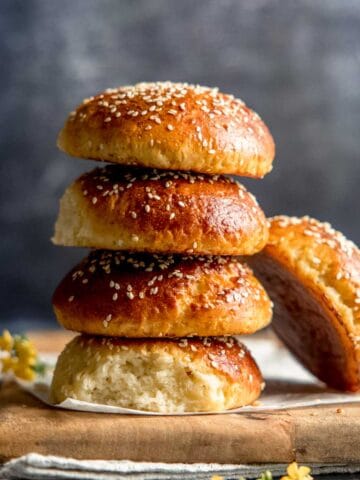
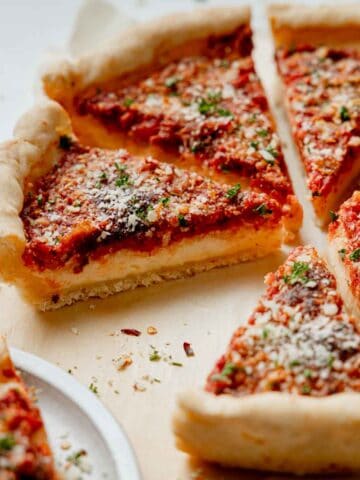
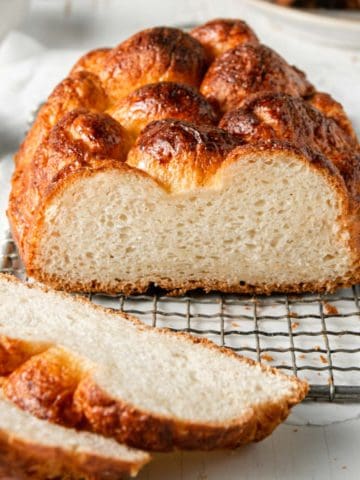

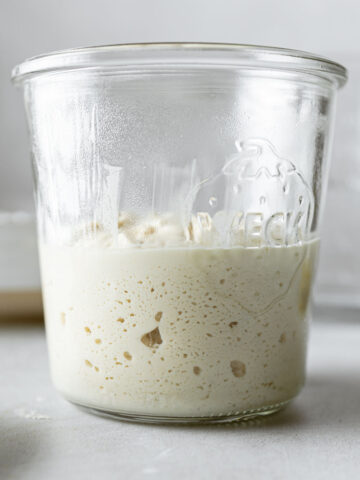
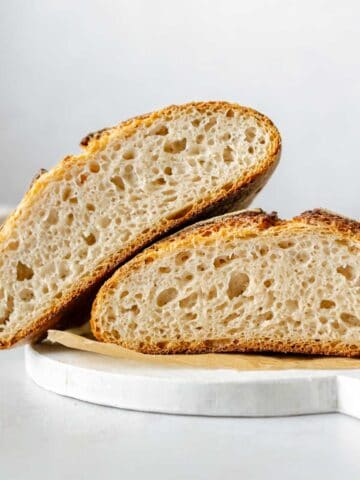
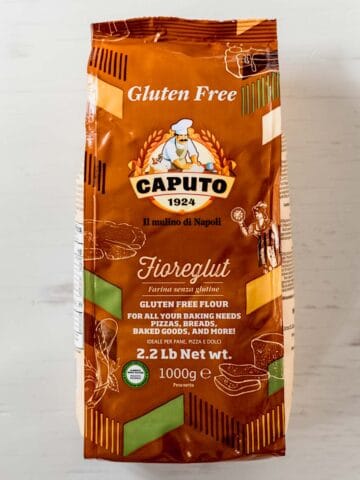
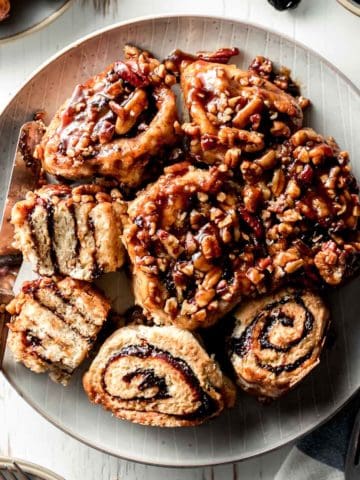
Christine
This is by far the BEST gluten free baked good I have ever made. In fact, these rolls are so good that I can’t keep the rest of my family (who do not have celiac) out of them. They come out perfect every time. Thank you so much for sharing!!
Susan
First time making the gf dinner rolls and they turned out great. All the rolls rose well and separated easily. Much better than most of the gf rolls we've gotten at the gf bakeries around our area. Next comes the hot cross buns!
Katie Olesen
I am glad you liked the recipe, Susan! Please let me know when you try the hot cross buns!
hayley
Could I use psyllium husk powder instead of whole psyllium husks?
Katie Olesen
Yes. It's a little stronger though, so use a bit less. About 3/4 tablespoon or 4 grams.
CD
Best gluten free rolls I have ever had! This flour blend is amazing.
Katie | Wheat by the Wayside
Based on the feedback about the rolls turning out more like a loaf than actual pull-apart rolls, I have tested the recipe again with the addition of whole psyllium husk. They turned out great! The addition of psyllium allows the batter to be a bit easier to work with and helps the rolls keep their shape instead of melding together.
The dough is still going to be batter-like but greased hands and a 5-10 minute rest before shaping will help. Also remember, you don’t need to manhandle the rolls. Just gently form a ball and plop them down. Hope everyone loves this recipe and has success!
Kimberly
I just made these into hamburger buns. I recommend people half the recipe to start using the options provided so no math involved. This will help get the hang of working with this batter/dough. It does help some to wait the 10 minutes and just spoon the batter into little hills. Then take buttered hands and shape it and smooth the top. After rising, which only took mine 40 minutes because I put them on low setting covered in my dehydrator to keep warm, they looked like hamburger buns. Mine were completely browned and totally ready in 15 minutes in the oven. That might be because they weren't smooshed together like dinner rlls. Most gluten free buns are heavy and crumbly, these are light and have great aereation holes in the bun when cut. I will make again.
Erica
Triple checked my measurements and the cake batter consistency would not let me "roll" anything, couldn't even pick them up. Had to scrape into loaf pan.
Waiting to see what the "loaf" will be like
Katie | Wheat by the Wayside
Sorry you didn't enjoy the recipe. I've noted in several places throughout this post that the batter is thick and sticky, which is normal. That is part of why they are light and fluffy in the end. I've modified the recipe to add psyllium which will help this issue a bit. The dough is still sticky though, so greased hands and a light touch go a long way. You can always use a cookie scoop to add the mounds of dough to the pan and then flatten the tops with greased or wet hands, as noted in the recipe.
Pete
The caputo bag says 90 grams for a cup of the flour, but when I added my flour by weight, it was too runny. What should it be by weight
Katie | Wheat by the Wayside
Click the metric button at the top of the ingredients list.
Nancy
Could this recipe be used to make hamburger buns? I've been searching for a Fioreglut hamburger bun receipe but am coming up empty.
Katie | Wheat by the Wayside
The dough is a little soft, so I'm not sure it would work so well. I will add this to my list of recipe to test with Fioreglut.
Heather
Have you ever made this bread using an egg replacer, for a vegan bread? Just wondering how it would work.
Katie | Wheat by the Wayside
Hi Heather, I haven't tried it.
Leah
hi! my husband has an egg allergy, and I regularly use JustEgg in all our baked goods. I just used it in this recipe as well - and used it with a bit of water as an egg wash as well. worked beautifully!
fyi, I typically use 3tbsp of JustEgg for every (1) large egg. hope that helps
Katie Olesen
Hi Leah, Thank you so much for this helpful tip! I am happy to hear it worked so well!
Valerie Havel
Katie, why did you change your recipe?? We absolutely loved your first version. No changes were needed. Following your guidance we make bread and buns with it too. Will you please repost the original so I can share it with a friend I was going to send it to?
Katie | Wheat by the Wayside
Ugh, I'm sorry. I wanted them to be more fluffy. Here's the old version, which based on feedback I may need to revert back to.
Ingredients
3 cups (360 g) Caputo Fioreglut Gluten-free Flour Blend, (other flour brands are not recommended.)
2 1/4 tsp Instant, Rapid Rise, or Breadmachine Yeast 1 tsp kosher salt
2 tsp sugar
1 cup milk
1/4 cup butter, (melted)
2 eggs
Preparation Steps
1. In the bowl of a stand mixer, whisk the dry ingredients.
2. Warm the butter and milk to 110-120F.
3. With the mixer on low, slowly stream in the milk and butter. Then blend in the eggs.
4. Continue to mix on medium speed for 2 minutes, scraping down the bowl occasionally.
5. Grease a 9-inch pan, pie plate, or 10x6.5 inch pan.
6. With a large cookie scoop, scoop 12 heaping 1/4 cup portions of dough into the pan. Place the scoops so they are touching on the sides. Use wet hands to flatten any peaks.
7. Cover the pan with plastic wrap. Place the pan in a warm spot and allow the rolls to rise for 1 hour or until doubled in size.
8. Heat the oven to 350°F. Remove the plastic wrap and brush the tops of the rolls with melted butter.
9. Bake at 350°F for 35-45 minutes. The rolls should be nicely golden brown when finished. (It is better to slightly overbake than underbake the rolls, so make sure they are nice and golden brown. Use a toothpick to check the centers if needed.) Brush tops with more melted butter. Serve while still warm.
Valerie Havel
Thank you so much! We primarily use it to make the BEST gluten free bread EVER! We also follow your pizza crust recipe and it’s great too! You’re the best!
Katie | Wheat by the Wayside
Aww!! Thank you! So glad you enjoy the recipes!!
KC Pure Transcending
Thank you so much for being you. The cinnamon rolls are amazing, I missed them so much. And then this recipe🥰 I had tried it for rolls for turkey day which is definately a go but I've been searching for a sandwich bread recipe and think this is it. I will definately be trying this in a loaf pan as well. I used the recipe posted in the comment. I learned a while back the importance of reading or at least glimpsing over the whole thing.
Katie Olesen
Glad you enjoyed the recipe KC! Thanks for sharing!
Nicole
Can you replace any sugars in the g-free breads/rolls with coconut sugar, honey, maple syrup, sugar in the raw, etc?
Katie | Wheat by the Wayside
Thanks for your question, Nicole. Any of the substitutions I've personally tested are noted in the blog post. I will keep alternative sugars in mimd as I continue to create and test recipes.
Noah Trent
These rolls are one of the best gluten free recipes I've tried. My wife is gluten free and finding things we both like is problematic at best.
These are easy to make but mine were very sticky and making smooth rolls didn't work well. So, since it was the consistency of frosting, I loaded up a baggie with it, snipped about an inch off of a corner, and squeezed the right amount like a soft ice cream cone. It worked perfectly and I managed more rise. They looked much better than the sticky roll in your hands technique. Excellent end result with both methods however, and everybody loved them for Thanksgiving dinner!! Thank you for an excellent dinner roll!. Caputo makes the best flours, period. Best gluten free pizza crust too! Highly recommended!
Katie | Wheat by the Wayside
Yes, it is sticky! When I tried with less moisture, the rolls were much more dense but the dough was easier to work with. I personally felt like a softer fluffier roll was worth the hassle of the sticky batter. That said, I think I am going to experiment with adding a little psyllium and see if that helps make the dough more workable but still fluffy. I will update the recipe if it works out. Thanks for the feedback!
LJSJ
All my balls of dough mushed together so I needed up with a pair of bread but it was the best loaf of bread I’ve ever made! I just sliced it and it was perfection. Super easy to make too! Spongy, fluffy, sweet and salty, didn’t care it wasn’t rolls.
Katie | Wheat by the Wayside
Thanks for the feedback. Glad you still enjoyed them. I have an idea to tweak this recipe, so I will update if it works out.
Sarah
Can you make this subbing oat milk for regular milk? I have all other ingredients except cows milk in the house and wanted to try them out!
Katie | Wheat by the Wayside
Yes, non-dairy milk will work as well! Enjoy!
Maria Lick
I love Caputo Gluten free flour! I've been using it for a while now. It makes a huge difference in baking bread. Hopefully the U.S. will be as accepting of the flour like Europe is. I even tested the flour before I first baked with it because of my concern with gluten free wheat starch and confirmed that it was safe. I've made focaccia bread with this flour that turned out amazing! I'll have to try your pizza crust soon.
Kathy
Great post. I did not know that about yeast. That could be why my pizza crust was dense. I used regular active dry yeast, but didn’t dissolve it first.
Katie Olesen
That could be it! Regular yeast needs to be dissolved first!